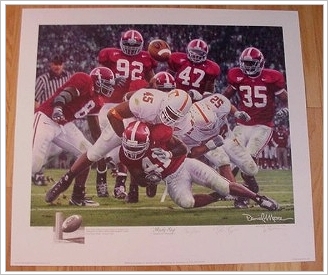 This Sunday’s New York Times included a nifty front page article on a pending lawsuit against Birmingham sports artist Daniel A. Moore filed by the University of Alabama. Our own Greg Skidmore covered this dispute back in April ’05 in this post. Moore has made what appears to be a pretty good living painting action shots of Alabama football games. His gallery’s web site is called Alabama Crimson Tide Prints.
This Sunday’s New York Times included a nifty front page article on a pending lawsuit against Birmingham sports artist Daniel A. Moore filed by the University of Alabama. Our own Greg Skidmore covered this dispute back in April ’05 in this post. Moore has made what appears to be a pretty good living painting action shots of Alabama football games. His gallery’s web site is called Alabama Crimson Tide Prints.
As Greg predicted, Mr. Moore has now moved to dismiss the case by arguing that the University lacks a right to control depiction of events of historic or public significance.
Mr. Moore has asked Judge R. David Proctor of the Federal District Court in Birmingham to dismiss the case on First Amendment grounds. His brief cited a decision of the federal appeals court in California ruling that a trademark owner “does not have the right to control public discourse” if “the public imbues his mark with a meaning.”The problem for Mr. Moore, is that unlike in other cases favoring artists’ rights, which may have involved slightly more transformative expression, his Alabama football paintings tend to be similar to the photographs he uses to compose his work.
After the citation, Mr. Moore’s lawyer, Stephen D. Heninger, added a parenthetical aside. “Who could argue with a straight face,” he asked, “that the cultural significance of Alabama football has not assumed such a role?”
I’m not sure I share all of the sentiments expressed in the article. For instance:
“This lawsuit is the equivalent of the Catholic Church suing Michelangelo for painting the Sistine Chapel,” said Keith Dunnavant, an Alabama alumnus and the author of “Coach: The Life of Paul ‘Bear’ Bryant.”The difference, of course, is that Michelangelo was commissioned by Pope Julius II to paint the Sistine Chapel, whereas Mr. Moore has not been commissioned by the University of Alabama.
Another questionable suggestion:
James Glen Stovall, who taught journalism at the university for 25 years, said only one sort of person would support the suit.To me, that does not give enough credit to the University’s claims. The University
“I can see why, if you’re sitting in a roomful of lawyers, you might come to that conclusion,” Mr. Stovall said. “But no one outside of that room would say: ‘Hey, that’s a good idea. Let’s sue Daniel Moore.’ ”
seemed to take particular offense at Mr. Moore’s use of his paintings on merchandise like coffee mugs and calendars.What’s really driving this case? Probably not Mr. Moore’s sale of a $25,000 watercolor or a $100 print, but rather his sale of a $2.00 coffee mug that eats into the University’s merchandising revenues. My guess is that, if the University survives Moore’s current motion to dismiss, the case will be headed towards some sort of settlement in which Moore ceases the sale of mugs and other trinkets emblazoned with his art in exchange for being allowed to continue selling the big ticket items.





0 comments:
Post a Comment